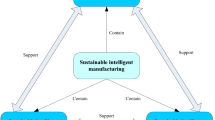Abstract
Tolerancing has great impact on the cost and quality of a product. Previous research essentially focussed on one-dimensional tolerancing where sized tolerances accumulate only in one direction. When sized and angular tolerances are considered simultaneously, tolerances accumulate, however, in two different directions in the given view plane. We utilize related tolerance zones to illustrate the accumulation processes of sized and angular tolerances. The orientational tolerances are converted into the equivalent sized or angular tolerances in terms of their engineering semantics. We establish the sequential linear optimization models to maximize the 2D sized, angular, and orientational working tolerances of a 3D machined part based on the process capabilities. At any completion stage of operations, we measure the processed sized dimensions and then substitute them into the dimensional chains to dynamically re-calculate the mean working dimensions for remaining operations. We also re-evaluate the working tolerances for remaining operations using sequential optimization models. This approach can release the working tolerances, reduce manufacturing costs, and enhance the acceptance rate of machined parts when we manufacture the complex, low-volume, and high-value-added parts. The approach is finally illustrated with a practical example.
Similar content being viewed by others
References
Ngoi KBA (1992) Applying linear programming to tolerance chart balancing. Int J Adv Manuf Technol 7:187–192
Ngoi BKA, Ong CT (1993) A complete tolerance charting system. Int J Prod Res 31:453–469
Ji P (1993) A linear programming model for tolerance assignment in a tolerance chart. Int J Prod Res 31:739–751
Ji P (1993) A tree approach for tolerance charting. Int J Prod Res 31:1023–1033
Wei CC, Lee YC (1995) Determining the process tolerances based on the manufacturing process capability. Int J Adv Manuf Technol 10:416–421
Lee YC, Wei CC (1998) Process capability-based tolerance design to minimize manufacturing loss. Int J Adv Manuf Technol 14:33–37
Ngoi BKA, Cheong KC (1998) An alternative approach to assembly tolerance analysis. Int J Prod Res 36:3067–3083
Lee YH, Wei CC, Chang CL (1999) Fuzzy design of process tolerance to minimize process capability. Int J Adv Manuf Technol 15:655–659
Chang CL, Wei CC, Chen CB (2000) Concurrent maximization of process tolerances using grey theory. Robot Comput Integr Manuf 16:103–107
Huang M, Gao Y, Xu Z, Li Z (2002) Composite planar tolerance allocation with dimensional and geometric specifications. Int J Adv Manuf Technol 20:341–347
Chen YB, Huang MF, Yao JC, Zhong YF (2003) Optimal concurrent tolerance based on the grey optimal approach. Int J Adv Manuf Technol 22:112–117
Gao Y, Huang M (2003) Optimal process tolerance balancing based on process capabilities. Int J Adv Manuf Technol 21:501–507
Huang MF, Zhong YR, Xu ZG (2005) Concurrent process tolerance design based on minimum product manufacturing cost and quality loss. Int J Adv Manuf Technol 25:714–722
Ngoi BKA, Ong JM (1999) A complete tolerance charting system in assembly. Int J Prod Res 37:2477–2498
Swift KG, Raines M, Booker JD (1999) Tolerance optimization in assembly stacks based on capable design. Proc Inst Mech Engrs 213(B):677–693
Ngoi BKA, Cheong KC (1998) The apparent path tracing approach to tolerance charting. Int J Adv Manuf Technol 14:580–587
Wang NX, Ozsoy TM (1993) Automatic generation of tolerance chains from mating relations represented in assembly models. ASME J Mech Des 115:757–761
Treacy P, Ochs JB, Ozsoy TM, Wang NX (1991) Automated tolerance analysis for mechanical assemblies modeled with geometric features and relational data structure. Comput Aided Des 23:444–453
Ramani B, Cheraghi SH, Twomey JM (1998) CAD-based integrated tolerancing system. Int J Prod Res 36:2891–2910
Chen KZ, Feng XA, Lu QS (2001) Intelligent dimensioning for mechanical parts based on feature extraction. Comput Aided Des 33:949–965
He JR, Gibson PR (1992) Computer-aided geometrical dimensioning and tolerancing for process-operation planning and quality control. Int J Adv Manuf Technol 7:11–20
Ngoi KBA, Tan CK (1995) Geometrics in computer-aided tolerancing charting. Int J Prod Res 33:835–868
Ngoi KBA, Seow MS (1996) Tolerance control for dimensional and geometrical specifications. Int J Adv Manuf Technol 11:34–42
Tseng YJ, Kung HW (1999) Evaluation of alternative tolerance allocation for multiple machining sequences with geometric tolerances. Int J Prod Res 37:3883–3900
Ngoi BKA, Lim LEN, Ong AS, Lim BH (1999) Applying the coordinate tolerance system to tolerance stack involving position tolerance. Int J Adv Manuf Technol 15:404–408
Ngoi BKA, Lim BH, Ang PS (2000) Nexus method for stack analysis of geometric dimensions and tolerancing (GDT) problems. Int J Prod Res 38:21–37
Zhao CG (1987) Graphical theory of dimensional chains and its applications. National Defense Industry Press, China
Fraticelli BP, Lehtihet EA, Cavalier TM (1997) Sequential tolerance control in discrete parts manufacturing. Int J Prod Res 35:1305–1319
Fraticelli BMP, Lehtihet EA, Cavalier TM (1999) Tool-wear effect compensation under sequential tolerance control. Int J Prod Res 37:639–651
Wheeler DL, Cavalier TM, Lehtihet EA (1999) An implicit enumeration approach to tolerance allocation in sequential tolerance control. IIE Trans 31:75–84
Cavalier TM, Lehtihet EA (2000) A comparative evaluation of sequential set point adjustment procedures for tolerance control. Int J Prod Res 38:1769–1777
Mcgarvey RG, Lehtihet EA, Castillo ED, Cavalier TM (2001) On the frequency and locations of set point adjustments in sequential tolerance control. Int J Prod Res 39:2659–2674
Acknowledgements
This research project is sponsored by the National Natural Science Foundation of China (grant No. 50465001) to Huang Meifa. The authors would like to thank the anonymous reviewer for their constructive comments on the earlier version of this paper.
Author information
Authors and Affiliations
Corresponding author
Rights and permissions
About this article
Cite this article
Meifa, H., Yanru, Z. Optimized sequential design of two-dimensional tolerances. Int J Adv Manuf Technol 33, 579–593 (2007). https://doi.org/10.1007/s00170-006-0475-9
Received:
Accepted:
Published:
Issue Date:
DOI: https://doi.org/10.1007/s00170-006-0475-9




